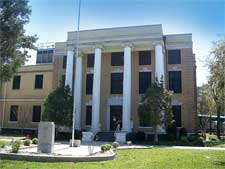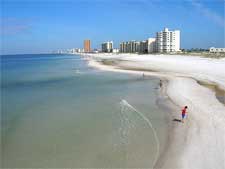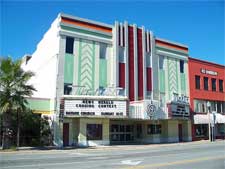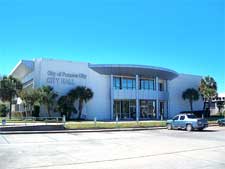Panama City History Facts and Timeline
(Panama City, Florida - FL, USA)

Panama City's history dates from when its first residents arrived some 13,000 years ago during the last ice age. The ancient shell midden (an archaeological site comprising mainly mollusk shells) in Oaks By The Bay Park contains some of the few surviving landmarks from Panama City's earliest residents.
More of these 5,000 to 2,500-year-old middens line the shores of St. Andrews Bay alongside fossils of woolly mammoths, sabre toothed cats and other long extinct wildlife. Temples were built on top of many shell middens by the year 700 AD and shell goods were traded as far north as present day
New York and
Minnesota.

History of the Earliest Residents
The Yucci and Chatot were the region's dominant tribes during the first Spanish contact period in Panama City history, around the turn of the 16th century. Although the Chatot soon died out, the Yucci survived by fleeing north and westwards.
Many of the region's first European visitors were pirates waiting to attack Spanish galleons filled with riches. One of these giant galleons, along with a huge cannon, was interestingly unearthed beneath a local motel during the early 1960s. Many more shipwrecks lie beneath St. Andrews Bay, which is considered the world's shipwreck capital to this day.

Permanent Settlement
In this era of Panama City's early history, the region remained sparsely populated for around two centuries, until the Cherokee and Creek tribes arrived to avoid forced relocation to the west. A retired Georgia governor and his wife were among the area's first permanent settlers and their family home later became a popular hotel.
Seminoles and white settlers formed most of the local population by the 1830s, but the area began to attract tourists interested in fishing and soaking in the Gulf of Mexico's waters. The salt extracted from the bay was said to successfully treat a number of ailments and was supplied to Confederate troops during the American Civil War (1861 to 1865). Federal soldiers frequently invaded the area's first town and destroyed it altogether in 1863.

Panama City Incorporation
Following the American Civil War, the area once again became a popular boat building, fishing and tourism community. The town of St. Andrews was officially incorporated in 1908, and Panama City was established in 1927 by annexing St. Andrews and three other neighboring communities. The city received its name because it was located on a direct rail line between
Chicago and its namesake in the Central American country of Panama.
Neighboring Panama City Beach was founded in 1936, while the city itself became a prominent WWII port and shipbuilding settlement. Today, Panama City Beach welcomes the bulk of the area's beach-goers, with the city itself functioning as the Bay County's cultural, business and administrative center.
Gleaming skyscrapers stand alongside Panama City's oldest buildings in its historic downtown district. Visitors can see some of southwest Florida's most beautiful sea creatures at the Gulf World Marine Park, or get up close to exotic land animals at the Zoo World Zoological and Botanical Park.
 Panama City's history dates from when its first residents arrived some 13,000 years ago during the last ice age. The ancient shell midden (an archaeological site comprising mainly mollusk shells) in Oaks By The Bay Park contains some of the few surviving landmarks from Panama City's earliest residents.
Panama City's history dates from when its first residents arrived some 13,000 years ago during the last ice age. The ancient shell midden (an archaeological site comprising mainly mollusk shells) in Oaks By The Bay Park contains some of the few surviving landmarks from Panama City's earliest residents.

